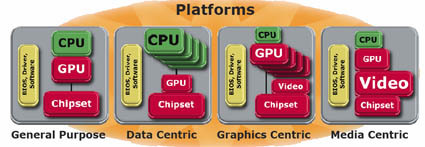AMD aims for major 65 nm transition by mid-2007
Sunnyvale (CA) - In a briefing with journalists, AMD provided and updated outlook on its future processor and manufacturing plans. The firms 65 nm processors will be introduced in December. The company trails Intel by about 12 months, but AMD believes it will make the jump to a product line that consists mainly of 65 nm CPUs within half a year.
The presentation indicated that a major transition to 65 nm will be occurring during the first and second quarter of next year. No specific processor models have been announced, but industry sources told TG Daily that AMD will be making four 65 nm processors available for vendor order on December 5 of this year: The first processors using the 65 nm "Brisbane" core will be the Athlon 64 X2 versions 4000+, 4400+, 4800+ and 5000+.
Roadmaps seen by TG Daily also indicate that 90 nm processors will be with us for quite a while and not rapidly disappear by mid-2007. Most 90 nm dual-cores and single-cores will remain in production at least until the mid of 2008 and high-end versions of the X2 series, including the upcoming 6000+, 5800+ and 5600+ will only be available in 90 nm throughout the next year. The 5400+ and 5200+ models will get 65 nm companions in Q2 of next year. The perhaps most 65 nm product introduction will be the "Agena" quad-core, which is expected to make its debut in early Q3 2007.
While AMD touts a quick move to 65 nm, the company is about one year behind its rival Intel. Intel is phasing out all remaining 90 nm processors, including the Pentium D 820, some Pentium 4 600-series versions as well as Celeron D processors throughout the first half of 2007 and will begin shipping 45 nm processors in Q4 of next year. AMD said that it has been developing its 45 nm process since the end of 2005 and accelerated its roadmap to introduce first 45 nm processors about 18 months after launching its first 65 nm chips - which would cut the distance to Intel down to about six months.
An area where the company may be able to create a new trend and carve out a leadership position may be stream computing and graphics processor integration. The previously announced "Fusion" processor, due in late 2008 or early 2009 will continue the integration model that AMD initiated with its "Hammer" processor architecture in 1999: Following the integration of the memory controller into the CPU package, the company will be adding a graphics processor.
AMDs vision of the graphics processor in computer platforms
This integration opens up a whole range of new application models - and not necessarily only graphics focused scenarios. While AMD envisions general purpose platforms of Fusion for lower-end and mainstream PCS, Fusion can also use the floating point performance of the GPU to expand into data centric and media centric applications as well as high-end graphics when using multiple GPU cores. More details about Fusion are expected to be unveiled during an analyst event in December.
Get Tom's Hardware's best news and in-depth reviews, straight to your inbox.
A first impression of the direction AMD is taking with the graphics processor was given with the introduction of the firm's first "stream processor". Basically a slightly modified Radeon graphics card with R580 processor, the technology looks like a regular graphics card, but integrates 1 GB of memory and is targeted to speed up applications in CAD and CAE, financial analytics, oil and gas exploration, as well as scientific programs such as molecular modeling, math libraries and gene sequencing.
Related article:
AMD preps launch of three FX processors for 4x4 platform
Tom's Hardware is the leading destination for hardcore computer enthusiasts. We cover everything from processors to 3D printers, single-board computers, SSDs and high-end gaming rigs, empowering readers to make the most of the tech they love, keep up on the latest developments and buy the right gear. Our staff has more than 100 years of combined experience covering news, solving tech problems and reviewing components and systems.

